12 Mistakes Everyone Makes With Canned Spinach
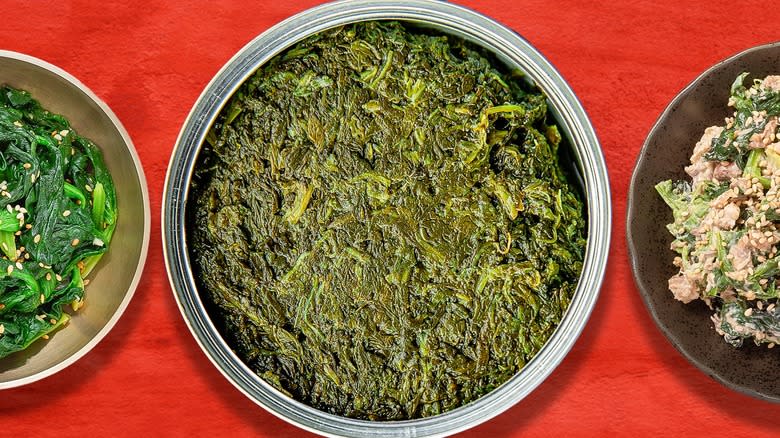
Canned foods tend to have a bad reputation for not tasting very good, not being very good for you, and not having the best texture. However, there are some varieties — like canned spinach — that are convenient, have nutritional benefits, and are quite tasty ... with the help of some tricks.
While canned spinach gives us flashbacks of old Popeye cartoons, it won't instantly give you huge biceps — but it's still good for you. In terms of vitamins and minerals, canned and fresh spinach are equally worth buying. There are numerous reasons to use canned spinach. It won't wilt into nothingness when cooked, causing a huge bag of fresh spinach to shrink into a tiny amount in your dish. It's especially handy to keep in your pantry for when you're short on fresh produce. And we've all had a bag of spinach that we had the best intentions for, but it withered away way too soon in the fridge — however, shelf-stable canned spinach doesn't break your heart like that, and it's easier on the pocketbook, too.
So really, what's not to love? Well, canned spinach isn't the most appealing food if it's not prepared correctly, and oftentimes, it's not. As a recipe developer, I love the convenience of canned spinach for using in various recipes that allow me to enhance what this ingredient does offer, and avoid what it doesn't. These are some of the mistakes everyone makes with canned spinach.
Read more: 16 Worst Canned Foods You Can Buy
Eating It Straight Out Of The Can

It might be unnecessary to mention this mistake, as most people aren't grabbing a can of spinach to munch on immediately. However, canned foods — especially prepared and cooked ones, like canned spinach — are often thought to be ready to eat, and therefore people can plop them out straight onto a plate, like you could with a can of baked beans.
Well, technically, you can. Canned spinach is cooked and safe to eat, and you certainly may eat it as is. However, canned spinach is not going to taste good at all if you eat it straight from the can, and this is also the case if adding it straight into a meal to be served, whether as a side dish or as an addition to a main course. It's a surefire way to turn anyone against this versatile canned vegetable, and we don't want that.
Instead, it's good to treat canned spinach as an ingredient to be played with somewhat. You still get the benefits of it being a convenience food. You don't have to wash canned spinach leaf by leaf, cut it, or initially cook it — but a little bit of effort can go a long way to make this a pantry staple to go back to again and again.
Not Draining The Can Of Spinach
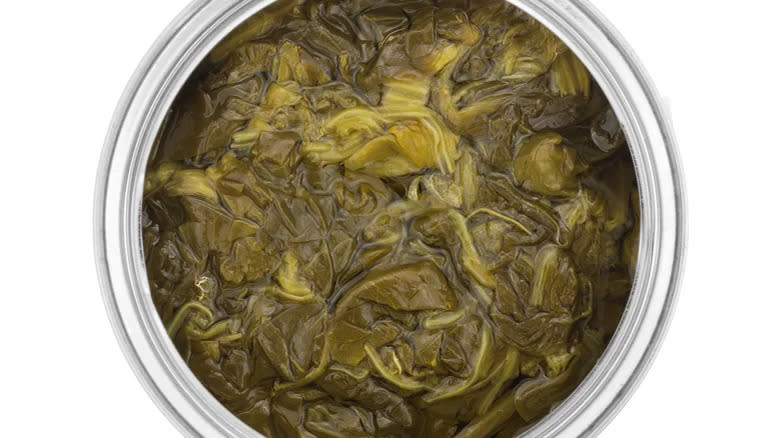
This is a rookie error that anyone can make with canned goods in general, but with spinach it's especially important. You have to drain canned spinach before adding it to your cooking, or the liquid that the spinach is preserved in will ruin the dining experience. The liquid doesn't have a particularly strong flavor, but it does taste a little metallic, and has the predictably unappealing mouthfeel of murky, salty spinach water.
This can be enough to turn anybody against spinach, even its fans. Plus, if you're dropping your spinach into a soup, stew, or another cooked dish, the brine is going to water down the finished dish, and actually detract from the flavor of what you're cooking. So drain your can of spinach, every single time.
The easiest way to go about draining your can is to use a sieve or colander. Simply pour all the contents of the can into the sieve, and let the water drain completely. A little gentle squeeze after draining won't hurt, to eject any extra liquid.
Thinking You Don't Need To Rinse Canned Spinach

One of the best things about using canned ingredients is that you don't have to wash your fruit and veggies. While it's true that there isn't a need to wash off any dirt or other contaminants, the way you must with fresh produce, there is some benefit to giving your canned vegetables a rinse. This is still more convenient than washing fresh spinach, because it does not require the same thoroughness needed to clean every leaf.
Just a little splash under some running water can help improve the flavor of your canned spinach greatly. While draining is the first step to removing all that murky brine that your spinach was steeped in, there's going to be some residue in the preserved leaves if you don't rinse it out.
Rinsing helps your spinach taste better not just because you're removing the unappetizing brine, but it also allows your spinach to absorb other flavors better. So, if you're going to add things like garlic, bacon, onion, or spices into your dish, they'll shine brighter if your spinach isn't coated in juice from the can. You can give it a rinse in the same sieve or colander that you drain the spinach in, and then when you're done, give it a shake and gently dry it off with a paper towel to begin cooking.
Overcooking The Spinach
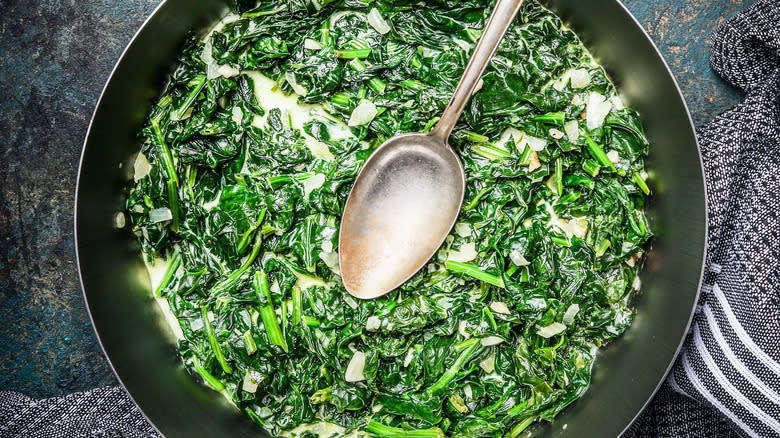
Something to bear in mind if you're cooking with canned spinach is that it's an ingredient that's already been cooked. This can make things tricky if, for example, you want to add it to a slow-cooked stew, because you don't want to end up overcooking it. Sadly, this is a mistake that many people make. SInce you're likely adding canned spinach at some step while your food is heating, it's easy to overcook this ingredient.
The problem is that canned spinach tastes awful when overcooked, and can become bitter enough to ruin an entire dish. This is perhaps why people say they don't like canned spinach, because it's probable that they've only tasted overcooked canned spinach.
This doesn't have to be the case, and with some strategizing, you can cook with canned spinach without overcooking it. Think of it as a finishing vegetable that only needs a couple minutes of cooking to absorb flavor and blend with the rest of your dish. It's actually pretty similar to fresh spinach in this regard, as you would only cook that for a short amount of time, too. So, if you're making a soup or a stew, let canned spinach be the last ingredient you add, rather than something you throw in at the beginning with the other veggies.
Underseasoning Your Spinach
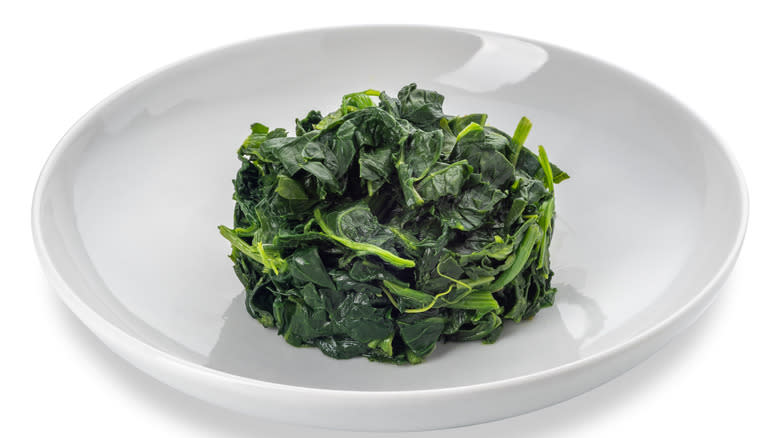
For folks who are looking for convenience above all else, dumping canned spinach into a dish and calling it a day might indeed be easy, but it's not gonna excite your taste buds. Even though canned spinach is often cooked with salt and could then technically be called "seasoned," you should make use of other seasonings to improve its flavor.
You can balance convenience and deliciousness if you learn how to season canned spinach to your liking. A dash of soy sauce or Worcestershire sauce could do wonders by adding some umami to your spinach, or a favorite spice blend can make a big difference.
Taste can be enhanced in other ways too. Choose extra virgin olive oil to coat the canned spinach and add some more depth. Consider sautéeing canned spinach in bacon grease, providing the easiest way to upgrade canned vegetables in general. There are many ways to make your canned spinach taste great, so don't be afraid of playing around with spices, fats, and various seasonings.
Not Thoroughly Heating Canned Spinach
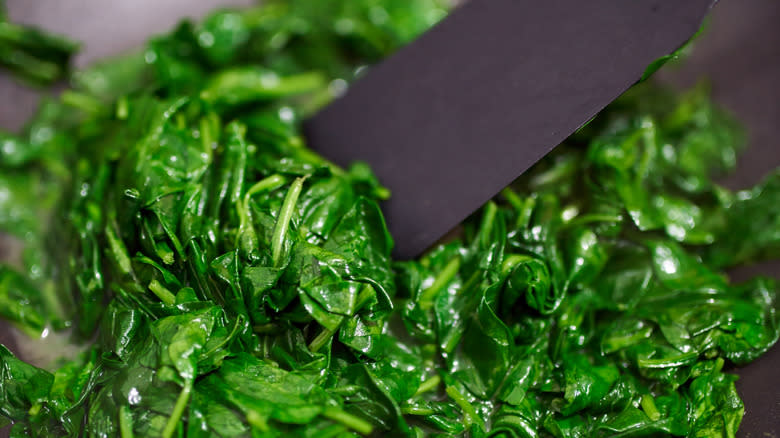
Since canned spinach is already cooked, it's understandable that you might not want to bother with heating it, or cooking it into another dish in some way. You might be looking for a vegetable side dish quick fix, and that's okay.
However, the worst thing you can do is serve room-temperature canned spinach. It's really important to at least warm it through before serving it, so that its warmth matches the rest of your meal, and is served with some element of care. Warming canned spinach also gives it a bit of a "just cooked" appearance, so that it feels less like a canned food.
Remember to drain your spinach and give it a rinse to wash away its briny taste. Pat the spinach dry and place it in a dish to be heated in the microwave. Alternatively, you can give it a quick toss in a frying pan, with a little bit of olive oil for a little flavor.
Choosing The Wrong Type Of Canned Spinach
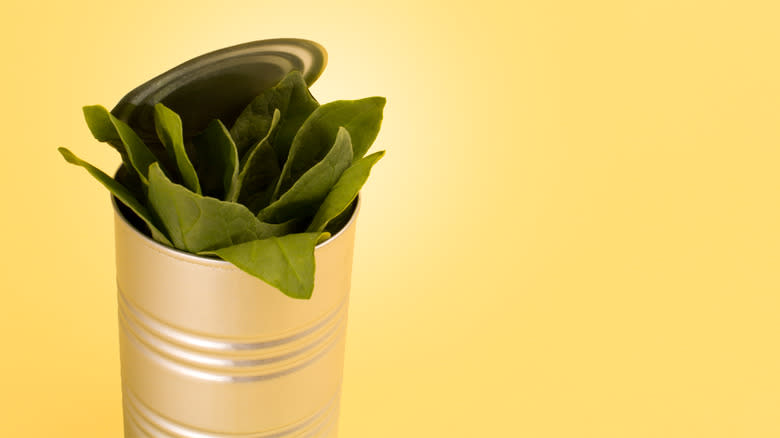
One truth about canned foods is that they're not all created equal. There are some brands that are just better than others, and this is definitely the case with canned spinach.
If you tried canned spinach before and hated it, perhaps you just need to try a different brand. It all comes down to preference, but it's worth sampling a few varieties to see what works best for your palate and cooking needs. You might also have a preference for whether you like canned spinach salted or unsalted, as well as chopped or whole leaf, and these factors will all determine how you prepare and use it. You can also find cans of Southern-style seasoned spinach, which you might prefer to the plain variety.
Online outlets provide recommendations for top-ranked canned spinach brands, or you can simply try out a couple varieties for yourself. Additionally, it's worth looking at the international food aisle — or even visiting more diverse grocery stores — to see how different cultures make canned spinach. For example, you might be pleasantly surprised to find a can of Indian-style spinach-based saag that's well seasoned and works better for your cooking preferences than plain canned spinach.
Forgoing An Acid

A mistake that many home cooks make is not balancing a dish with disparate elements. One of those is acid. A simple squeeze of lemon or a dash of vinegar can do wonders for all sorts of things, and this couldn't be truer with canned spinach. While you may have neutralized the flavor of canned spinach by rinsing away the brine, this preserved veggie can still taste a little dull without something extra to lift it.
This is where a hint of acid comes in. It will instantly brighten up your canned spinach, and make it taste as close to freshly cooked spinach as you can get. Paired with some olive oil, salt, and a squeeze of lemon, your canned spinach will be pretty tasty and well balanced.
There are many options for acidic ingredients to use. You can squeeze limes instead of lemons, or perhaps try another type of citrus you love. You can drizzle some balsamic vinegar for sharpness with a hint of sweetness, or you can use apple cider vinegar. Any of these will add a delightful flavor to canned spinach with only a few drops. Try making an easy sautéed spinach soup recipe with a can of spinach, and don't forget to squeeze in some lemon juice at the end.
Serving Canned Spinach Plain

You'd be doing yourself and your spinach a disservice by serving it as is from the can. It's not technically wrong to eat it plain — as in, it won't be inedible — but it's going to be bland and not very appetizing. Even if you love the flavor of spinach on its own, this is not going to be a great eating experience — especially when there are so many tasty ways to use canned spinach as an ingredient. By trying out new recipes that enhance your canned spinach, and let it play to its strengths rather than its weaknesses, canned spinach will encourage you to take it out of the depths of your cupboard more often.
For a really easy way to use canned spinach, add it to frittata recipes or a quiche, or make some tangy spinach soup. You can also whip up a creamy artichoke and spinach dip to have as a snack or appetizer for your next get-together with friends. If you're cooking a weeknight lasagna, throw in some canned spinach to increase your vegetable intake, or blitz some into a nutty green pesto sauce for a pasta or gnocchi dish. When making beef or lamb stew, adding in some canned spinach couldn't be easier. The possibilities are truly endless.
Adding It To Your Dish Too Late
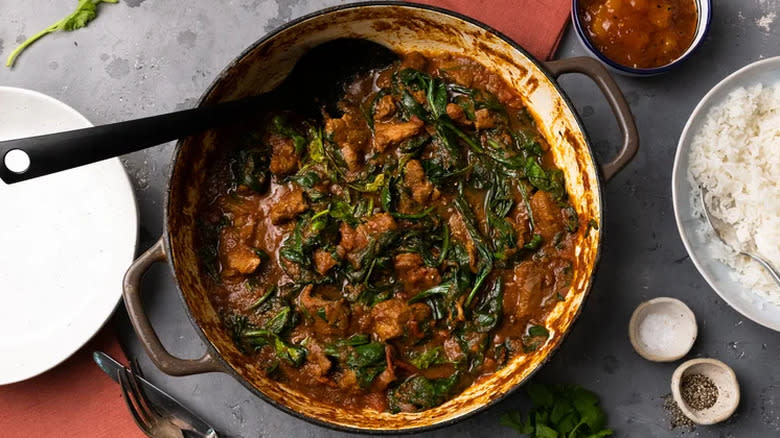
We've established that canned spinach is a versatile and handy ingredient to use in your cooking. However, as it's already cooked, we must remember that overcooking it is a bad idea. This makes it imperative to know what stage of the cooking process to add canned spinach. While it's a good idea to incorporate spinach near the end of the cooking time, there is a risk of adding it a little too late. Yes, you won't run the risk of overcooking it, but you also don't want your canned spinach to taste completely disjointed from the rest of the meal.
Using canned spinach would work great if you're making a dish like hearty minestrone soup, or perhaps a comforting lamb saag. Letting your spinach cook for just a couple minutes in your stew, soup, or sauce will give the vegetable a chance to absorb the flavors of your dish a little more. This way, your spinach will add its own flavor too, and therefore become a part of the meal. Your dish will have a more unified taste, and you'll have a better overall result.
Keeping Leftover Spinach In The Can

It's possible that a whole can of spinach may be a little bit too much for whatever you're using it for. There's no need to force yourself to use the entire amount in one go, and you can keep the rest in the refrigerator for a couple of days to be used for something else later.
However, people make the mistake of keeping leftover spinach in the same can that it came in, and this isn't a good idea. Your spinach is going to develop an unpleasant taste that will be difficult to get rid of. You may end up tossing your leftover spinach instead of using it, and thus waste food.
It's considered safe to refrigerate an open can of spinach for less than four days, but this is not advised for maintaining the product's quality. Instead, decant your remaining spinach into a proper food-storage container and then place it into your fridge.
Substituting Fresh Spinach For Canned Spinach In Everything
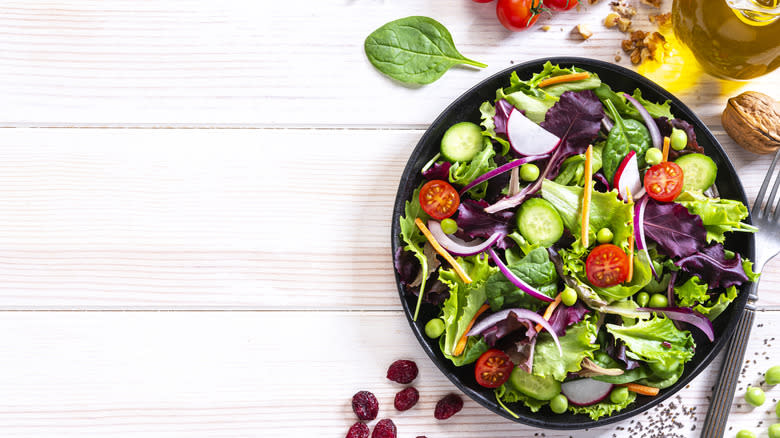
Canned spinach can be used in myriad ways, but it's also important to know which ways work the best, and which ways to avoid. We cannot compare canned spinach to fresh spinach in a lot of regards. They are simply two very different ingredients. Sadly, this means that canned spinach can never be used as a substitute in any recipe that specifically calls for fresh spinach — you'll be highly disappointed if you try it.
Fresh spinach can be used for cooking or eaten raw, and people often add raw spinach to salads and other cold foods. This is a delicious way to eat fresh spinach, and many people prefer to eat spinach raw rather than cooked, because of both taste and texture.
However, canned spinach should never be used in a salad — you'll end up with a soggy mess that you won't enjoy eating. The same applies to other applications for fresh spinach, such as on sandwiches. Canned spinach is cooked spinach, so in recipes you have to use canned spinach only in place of cooked fresh spinach.
Static Media owns and operates Tasting Table and Daily Meal.
Read the original article on Tasting Table.


